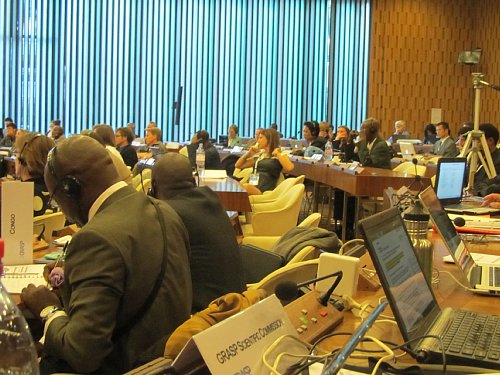|
<NEWS>
GRASP in Paris 2012
Tetsuro Matsuzawa1,2
1. Primate Research Institute, Kyoto University, Japan 2. President of International Primatological Society GRASP, which stands for the Great Apes Survival Partnership, is a joint program of UNESCO and UNEP. The 1st GRASP council meeting was held in Kinshasa, Congo, in 2005. The discussion at the time resulted in the Kinshasa Declaration on Great Apes. The 2nd meeting of the GRASP council was held in November 6–8th, 2012, in the headquarters of UNESCO, Paris, France. The author is a member to the Scientific Commission (SC) of GRASP. The SC consists of experts on wild great apes and acts to provide scientific advice to GRASP. 
Figure 1. The 2nd GRASP Council was held 6–8 November 2012 at UNESCO headquarters in Paris. The GRASP 2012 council meeting in Paris aimed to define and prioritise actions for the coming years. The new GRASP coordinator, Douglas Cress, took the lead at this international gathering, which included predominantly representatives of range countries, donor countries, NGOs and UN-related organizations. I estimate that about 150 people gathered for this 3-day meeting. There was a lot of exchange of information about the current situation of great apes and major threats to their survival including habitat loss, poaching and the bush-meat trade, as well as the illegal international trade and the risk of disease transmission. The core of the discussions and output documents are available on the GRASP website. Please visit the website (/http://www.un-grasp.org/) for an update on GRASP activities. This report simply aims to publicize that the second GRASP council meeting was held in Paris to revitalize conservation efforts for wild great apes across their range. There are many ongoing activities at different levels aimed at promoting conservation of great apes in the wild. In this context, it might be helpful to mention the different roles of three organizations: the International Primatological Society (IPS), IUCN, and GRASP. IPS is the international academic society of primatologists. It holds biennial meetings. IPS 2010 was held in Kyoto, Japan, IPS 2012 was just held in Cancun, Mexico, and IPS 2014 will be held in Hanoi in Vietnam. The IPS comprises scientists across various disciplines who study non-human primates (NHPs). The IPS plays a key role in the scientific approach to conservation of NHPs, because the majority is either endangered or threatened. It is very important to acknowledge that there exists a wide variety of primate species, other than just great apes. IPS has a vice-president for conservation. The IUCN species survival commission (SSC) also unites scientists, taxon experts whose role is, among others, to evaluate the conservation status of species and regularly update the IUCN Red List of threatened species. The IUCN SSC includes a Primate Specialist Group (PSG). The PSG has a Section on Great Apes (SGA). The IUCN-PSG-SGA consequently focuses on the conservation of great apes from a scientific viewpoint. GRASP differs from IPS and IUCN-SSC in its ability for advocacy. As part of the United Nations organization, GRASP can, for instance, help to influence policy-makers, to promote green economy strategies, and to improve law enforcement coordination worldwide to the benefit of great apes. This level of effort is essential if we are to resolve conservation challenges lying beyond national borders, producing a real impact on conservation through policy-making whilst balancing conservation and economic development. I am writing this short note in Bossou, Guinea, West Africa, where the Kyoto University team has been carrying out a longitudinal study of chimpanzees in Bossou and Nimba. Among other tool uses and remarkable behaviors, Bossou chimpanzees are most well-known for their use of a pair of mobile stones to crack open oil palm nuts. However, in recent years, the Bossou chimpanzees have been declining in numbers, with only 12 individuals remaining today. If this community were to become extinct, its unique culture will disappear with it. Mount Nimba, 4 km away from Bossou, is the only natural World Heritage Site (WHS) in Guinea; however, this mountain range, which is rich in high grade iron-ore, continuously faces the threat of mining. We have, for many years now, been taking the initiative to plant trees between Bossou and Nimba to connect the two areas while also encouraging natural regeneration; this project is known as the Green Corridor Project. Science in the field should accompany in situ conservation efforts, just like science in the laboratory should aim to support welfare of captive animals. In various places, field scientists are making their own grass-roots efforts. I hope that activities at all levels will complement one another to improve the conservation of great apes and ensure their long-term survival in the wild. Back to Contents |